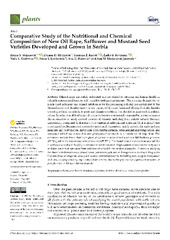Приказ основних података о документу
Comparative Study of the Nutritional and Chemical Composition of New Oil Rape, Safflower and Mustard Seed Varieties Developed and Grown in Serbia
| dc.creator | Stojanović, Z. | |
| dc.creator | Uletilović, Dajana D. | |
| dc.creator | Kravić, S. | |
| dc.creator | Kevrešan, Žarko | |
| dc.creator | Grahovac, Nada | |
| dc.creator | Lončarević, Ivana | |
| dc.creator | Đurović, A. | |
| dc.creator | Marjanović-Jeromela, Ana | |
| dc.date.accessioned | 2023-06-14T08:07:59Z | |
| dc.date.available | 2023-06-14T08:07:59Z | |
| dc.date.issued | 2023 | |
| dc.identifier.issn | 2223-7747 | |
| dc.identifier.uri | http://fiver.ifvcns.rs/handle/123456789/3585 | |
| dc.description.abstract | Oilseed crops are widely cultivated and are related to nutrition and human health as valuable nutraceutical sources with valuable biological properties. The growing demand for oil plants used in human and animal nutrition or for the processing industry has contributed to the diversification and development of a new variety of oil crops. Increased oil crop diversity, besides ensuring reduced sensitivity to pests and climate conditions, has also led to improved nutritional values. In order to enable oil crop cultivation to become commercially sustainable, a comprehensive characterization of newly created varieties of oilseeds, including their nutritional and chemical composition, is required. In this study, two varieties of safflower and white and black mustard were investigated as alternative oil species for nutritional parameters, mainly protein, fat, carbohydrate, moisture, ash, polyphenols, flavonoids, chlorophylls contents, acids and mineral composition, and compared with those of two different genotypes of rapeseeds as a traditional oil crop plant. The proximate analysis found that the highest oil content was found in the oil rape NS Svetlana genotype (33.23%), while the lowest was in black mustard (25.37%). The protein content varies from around 26% in safflower samples to 34.63%, determined in white mustard. High content of unsaturated fatty acids and low content of saturated fatty acid was observed in the analyzed samples. In mineral analysis, the dominant elements were phosphorus, potassium, calcium and magnesium, in descending order. The observed oil crops are also good sources of microelements, including iron, copper, manganese and zinc, accompanied by high antioxidant activity due to the presence of significant amounts of polyphenolic and flavonoid compounds | sr |
| dc.language.iso | en | sr |
| dc.publisher | Basel : MDPI | sr |
| dc.relation | info:eu-repo/grantAgreement/MESTD/inst-2020/200134/RS// | sr |
| dc.relation | APV 142-451-3150/2022-01/01 financed by the Provincial Secretariat for Higher Education and Scientific Research, AP Vojvodina | sr |
| dc.rights | openAccess | sr |
| dc.rights.uri | https://creativecommons.org/licenses/by/4.0/ | |
| dc.source | Plants - Basel | sr |
| dc.subject | oilseeds | sr |
| dc.subject | safflower | sr |
| dc.subject | mustard | sr |
| dc.subject | rapeseed | sr |
| dc.subject | nutritional value | sr |
| dc.subject | chemical composition | sr |
| dc.title | Comparative Study of the Nutritional and Chemical Composition of New Oil Rape, Safflower and Mustard Seed Varieties Developed and Grown in Serbia | sr |
| dc.type | article | sr |
| dc.rights.license | BY | sr |
| dc.citation.rank | M21~ | |
| dc.citation.spage | 2160 | |
| dc.citation.volume | 12 | |
| dc.identifier.doi | 10.3390/plants12112160 | |
| dc.identifier.fulltext | http://fiver.ifvcns.rs/bitstream/id/9526/bitstream_9526.pdf | |
| dc.identifier.scopus | 2-s2.0-85161599342 | |
| dc.type.version | publishedVersion | sr |


